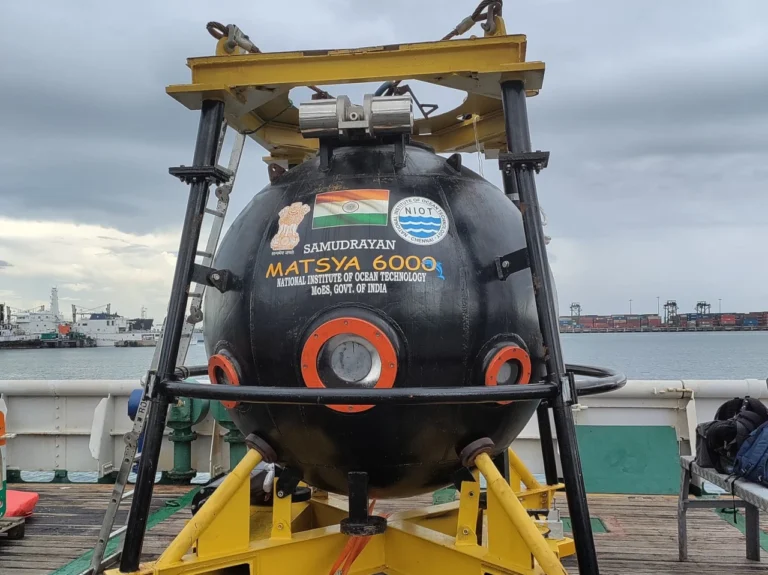
India’s Ambitious Mission to Send Humans to the Deepest Depths of the Ocean
Advertisement
India is gearing up to send humans to the deepest depths of the ocean in an ambitious mission called Samudrayaan. The mission will involve sending a manned submersible, called Matsya 6000, to a depth of 6,000 meters.
The first sea trials for the Matsya 6000 are scheduled to take place in the first quarter of 2024. The submersible will be piloted by three people, including a pilot and two scientists. It will be equipped with a variety of scientific instruments to study the deep ocean environment.
The Samudrayaan mission is expected to be completed by 2026. It will have a number of scientific objectives, including:
- Exploring the deep ocean environment and its biodiversity
- Studying the geology and mineral resources of the deep ocean
- Developing technologies for deep-sea exploration and exploitation
- Promoting the development of India’s blue economy
The Samudrayaan mission is a major undertaking, but it is one that India is well-positioned to undertake. The country has a long history of ocean exploration, and it has a strong scientific and technological base.
The success of the Samudrayaan mission would be a major milestone for India and would put the country in the forefront of deep-sea exploration. It would also help to boost India’s blue economy, which is estimated to be worth over $1 trillion.
The Samudrayaan mission is a bold and ambitious undertaking, but it is one that has the potential to make a significant contribution to science and technology. It is a mission that India is well-positioned to undertake, and it is one that the country should be proud of.
Here are some of the benefits that India could reap from the Samudrayaan mission:
- Improved understanding of the deep ocean environment and its resources
- New discoveries about the deep ocean’s biodiversity
- Development of new technologies for deep-sea exploration and exploitation
- Boost to India’s blue economy
- Increased international cooperation in deep-sea research
The Samudrayaan mission is a significant undertaking, but it is one that has the potential to yield many benefits for India and the world.
Advertisement
FAQs on India’s ambitious mission with Matsya:
What is the Samudrayaan mission?
The Samudrayaan mission is an Indian deep-sea exploration mission that will send a manned submersible, called Matsya 6000, to a depth of 6,000 meters.
When will the Samudrayaan mission be launched?
The Samudrayaan mission is expected to be launched in 2024.
Who will be on board the Matsya 6000?
The Matsya 6000 will be piloted by three people, including a pilot and two scientists.
What will the Matsya 6000 be equipped with?
The Matsya 6000 will be equipped with a variety of scientific instruments to study the deep ocean environment, including cameras, sonar, and sensors.
What are the scientific objectives of the Samudrayaan mission?
The Samudrayaan mission will have a number of scientific objectives, including:
* Exploring the deep ocean environment and its biodiversity
* Studying the geology and mineral resources of the deep ocean
* Developing technologies for deep-sea exploration and exploitation
* Promoting the development of India’s blue economy
What are the benefits of the Samudrayaan mission?
The Samudrayaan mission could have a number of benefits, including:
* Improved understanding of the deep ocean environment and its resources
* New discoveries about the deep ocean’s biodiversity
* Development of new technologies for deep-sea exploration and exploitation
* Boost to India’s blue economy * Increased international cooperation in deep-sea research
What are the challenges of the Samudrayaan mission?
The Samudrayan mission faces a number of challenges, including:
* The extreme conditions of the deep ocean, such as the high pressure and cold temperatures
* The limited availability of oxygen and food for the crew
* The risk of technical malfunctions
How is India preparing for the Samudrayaan mission?
India is preparing for the Samudrayaan mission by developing the Matsya 6000 submersible and training the crew.
What is the budget for the Samudrayaan mission?
The budget for the Samudrayaan mission is estimated to be around $100 million.
Who is funding the Samudrayaan mission?
The Samudrayaan mission is being funded by the Indian government.
What are the risks of the Samudrayaan mission?
The Samudrayaan mission faces a number of risks, including:
* The crew could be injured or killed in a technical malfunction
* The submersible could be lost at sea
* The mission could be delayed or canceled due to unforeseen circumstances
What are the chances of success for the Samudrayaan mission?
The chances of success for the Samudrayaan mission are good. India has a long history of ocean exploration, and the country has a strong scientific and technological base.
What are the implications of the Samudrayaan mission for India?
The Samudrayaan mission could have a number of implications for India, including:
* Increased scientific knowledge about the deep ocean
* Development of new technologies for deep-sea exploration and exploitation
* Boost to India’s blue economy
* Increased international cooperation in deep-sea research
What are the implications of the Samudrayaan mission for the world?
The Samudrayaan mission could have a number of implications for the world, including:
* Increased understanding of the deep ocean environment
* New discoveries about the deep ocean’s biodiversity
* Development of new technologies for deep-sea exploration and exploitation
* Increased international cooperation in deep-sea research
What is the future of the Samudrayaan mission?
The Samudrayaan mission is a long-term project. If successful, it could pave the way for future missions to explore the deepest depths of the ocean.